MARKETING
Diving for Pearls: A Guide to Long Tail Keywords – Next Level

Welcome to this refreshed installment of our educational Next Level series! Originally published in June 2016 this blog has been rewritten to include new tool screenshots and refreshed workflows. Together we’ll uncover keywords in the vastness of the long tail.
Looking for more Next Level posts? Previously we explored how to create relevant and engaging SEO reports.
One of the biggest obstacles to driving forward your business online is being able to rank well for keywords that people are searching for. Getting your lovely URLs to show up in those precious top positions — and gaining a good portion of the visitors behind the searches — can feel like an impossible dream. Particularly if you’re working on a newish site on a modest budget within a competitive niche.
Well, strap yourself in, because today we’re going to live that dream. I’ll take you through the bronze, silver, and gold levels of finding, assessing, and targeting long tail keywords so you can start getting visitors to your site that are primed and ready to convert.
Quick steps to building a long tail keyword list:
-
Draw from your industry and customer knowledge
-
Add suggestions from Google Autocomplete
-
Explore industry language on social media
-
Pull relevant suggestions from a keyword tool
-
Prioritize using popularity and difficulty metrics
-
Understand the competitive landscape to pinpoint opportunities
What are long tail keywords?
The “long tail of search” refers to the many weird and wonderful ways the diverse people of the world search for any given niche.
People (yes, people! Shiny, happy, everyday, run-of-the-mill, muesli-eating, credit-card-swiping people!) rarely stop searching broad and generic ‘head’ keywords, like “web design” or “camera” or “sailor moon.”
They clarify their search with emotional triggers, technical terms they’ve learned from reading forums, and compare features and prices before mustering up the courage to commit and convert on your site.
The long tail is packed with searches like “best web designer in Nottingham” or “mirrorless camera 4k video 2016” or “sailor moon cat costume.”
This adaptation of the Search Demand Curve chart visualizes the long tail of search by using the tried and tested “Internet loves cats + animated gifs are the coolest = SUCCESS” formula.
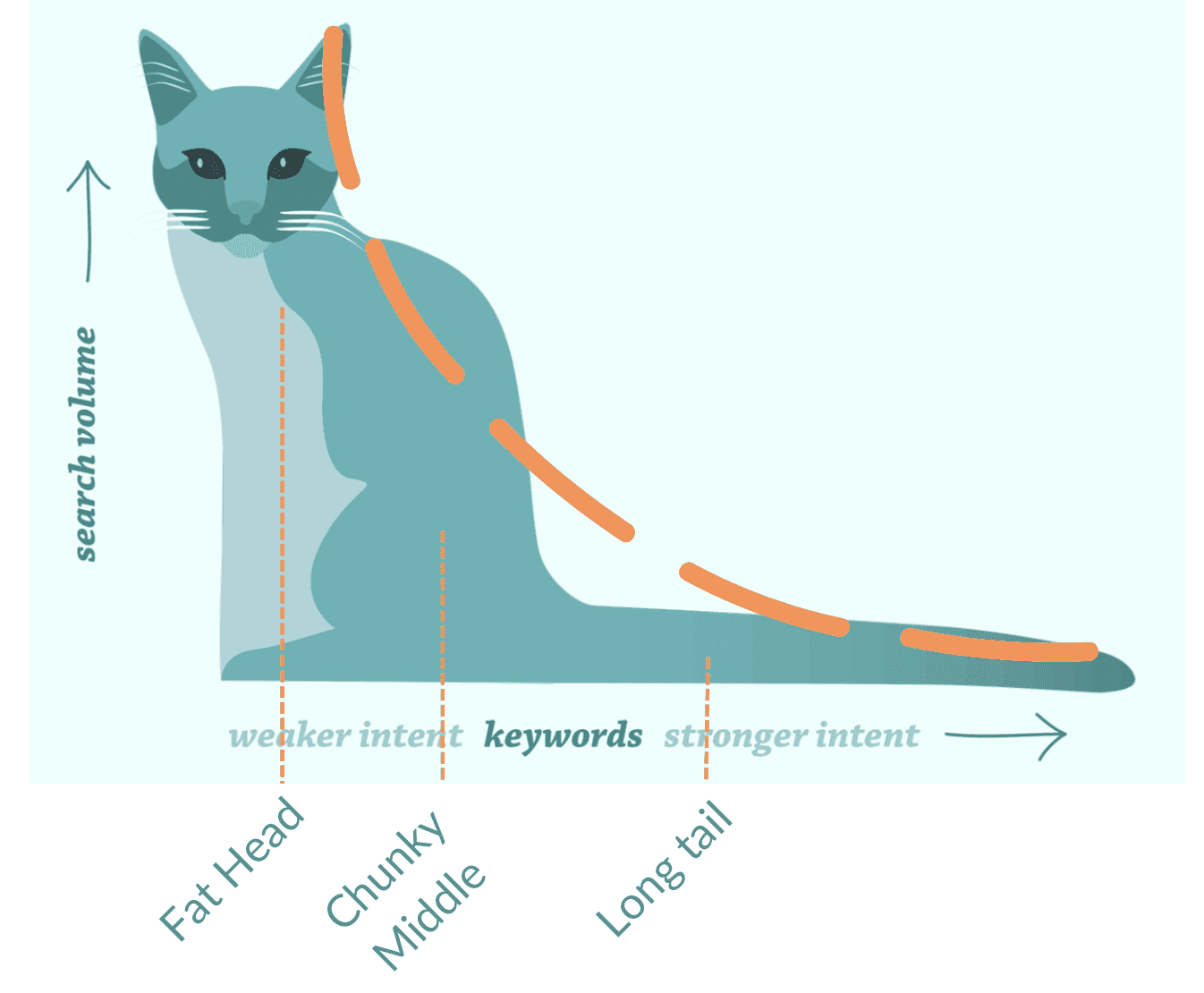
The Search Demand Curve illustrates that while “head” and “body” terms typically amass higher search volume, seeming appealing at first. The vastness of the “long tail” presents a more substantial opportunity and larger percentage of search traffic that shouldn’t be ignored. You can really see this illustrated when combined as a percentage of search traffic. While this graph contains no cats, it is still entirely illustrative. However the long tail of search isn’t slowing down anytime soon with voice search and AI integrations we can expect the vastness of the long tail to continue to grow.

While search volume for any individual long tail keyword is typically less, user intent is much more specific and viewed as a group targeting the long tail often enables you to target a larger more engaged audience. Also beautifully illustrated in Dr. Pete’s infamous chunky thorax post.
The long tail of search is being constantly generated by people seeking answers from the Internet hive mind. There’s no end to what you’ll find if you have a good old rummage about, including: Questions, styles, colors, brands, concerns, peeves, desires, hopes, dreams… and everything in between.
Fresh, new, outrageous, often bizarre keywords. If you’ve done any keyword research you’ll know what I mean by bizarre. Things a person wouldn’t admit to their best friend, therapist, or doctor they’ll happily pump into Google and hit search. In this post we’re going to go diving for pearls: keywords with searcher intent, high demand, low competition, and a spot on the SERPs just for you.
Bronze medal: Build your own long tail keyword
It’s really easy to come up with a long tail keyword. You can use your brain, gather some thoughts, take a stab in the dark, and throw a few keyword modifiers around your ‘head’ keyword.
Have you ever played that magnetic fridge poetry game? It’s a bit like that. You can play online if (like me) you have an aversion to physical things.
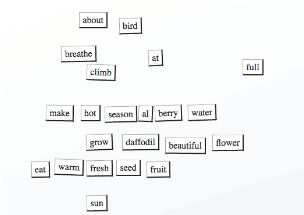
I’m no poet, but I think I deserve a medal for this attempt, and now I really want some “hot seasonal berry water.”
Magnetic poetry not doing it for you? Don’t worry — that’s only the beginning.
Use your industry knowledge
Time to draw on that valuable industry knowledge you’ve been storing up, jot down some ideas, and think about intent and common misconceptions. I’m going to use the example pearls or freshwater pearls in this post as the head term because that’s something I’m interested in.
Let’s go! Let’s say I run a jewelry business and I know that my customers regularly have questions, like:
How do I clean freshwater pearls
Using my knowledge I can rattle off and build a keyword list.
Search your keyword
Engage google suggested search tool to get some more ideas. Manually enter your keyword into Google and prompting it to populate popular suggestions, like I’ve done below:
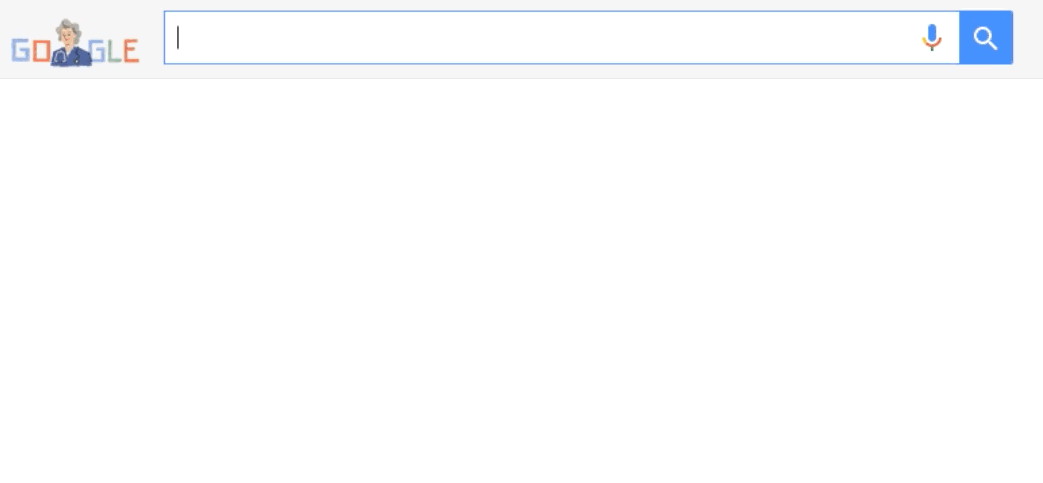
Awesome, I’m adding Freshwater pearls price to my list.
Explore the language of social media
Get amongst the over-sharers and have a look at what people are chatting about on social media by searching your keyword in Twitter, tiktok, Instagram, and Youtube. These are topics in your niche that people are talking about right now.
YouTube is also pulling up some interesting ideas around my keyword. This is simultaneously helping me gather keyword ideas and giving me a good sense about what content is already out there. Don’t worry, we’ll touch on content later on in this post. 🙂

I’m adding understanding types of pearls and Difference between saltwater and freshwater pearls to my list.
Ask keyword questions…?
You’ll probably notice that I’ve added a question mark to a phrase that is not a question, just to mess with you all. Apologies for the confusing internal-reading-voice-upwards-inflection.
Questions are my favorite types of keywords. What!? You don’t have a fav keyword type? Well, you do now — trust me.
Answer the Public is packed with questions radiating out from your seed term
Pop freshwater pearls into the tool and grab some questions for our growing list.
To leave no rock unturned (or no mollusk unshucked), let’s pop over to Google Search Console to find keywords that are already sending you traffic (and discover any mismatches between your content and user intent.)
Pile these into a list, like I’ve done in this spreadsheet.
Now this is starting to look interesting: we’ve got some keyword modifiers, some clear buying signals, and a better idea of what people might be looking for around “freshwater pearls.”

Should you stop there? I’m flabbergasted — how can you even suggest that?! This is only the beginning. 🙂
Silver medal: Assess demand and explore topics
So far, so rosy. But we’ve been focusing on finding keywords, picking them up, and stashing them in our collection like colored glass at the seaside.
To really dig into the endless tail of your niche, you’ll need a keyword tool like our very own Keyword Explorer. This is invaluable for finding topics within your niche that present a real opportunity for your site.
If you’re trying out Keyword Explorer for the first time, you’ll have 10 free searches/mo with a free Moz Community account and even more with a Moz Pro free trial or paid subscription.
Find search volume for your head keyword
To start, enter a broad industry keyword. In my case I’ll type in “pearls” into the Keyword Explorer search box. Now you can see Moz’s Monthly Volume displaying how often a term or phrase is searched for in Google:

Now try “freshwater pearls.” As expected, the search volume goes down, but we’re getting more specific.
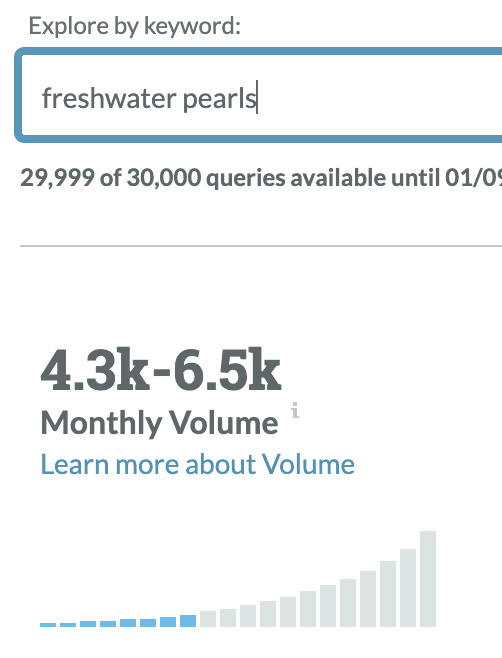
We could keep going like this, but we’re going to burn up all our free searches. Just take it as read that, as you get more specific and enter all the phrases we found earlier, the search volume will decrease even more. There may not be any data at all. That’s why you need to explore the searches around this main keyword.
Find even more long tail keywords
Below the search volume, click on “Keyword Suggestions.”

Well, hi there, ever-expanding long tail! We’ve gone from a handful of keywords pulled together manually from different sources to 1,000 suggestions right there on your screen. Positioned right next to that, search volume to give us an idea of demand.
The diversity of searches within your niche is just as important as that big number we saw at the beginning, because it shows you how much demand there is for this niche as a whole. We’re also learning more about searcher intent.
I’m scanning through those 1,000 suggestions and looking for other terms that pop up again and again. I’m also looking for signals and different ways the words are being used to pick out words to expand my list.
I like to toggle between sorting by Relevancy and search volume, and then scroll through all the results to cherry-pick those that catch my eye.
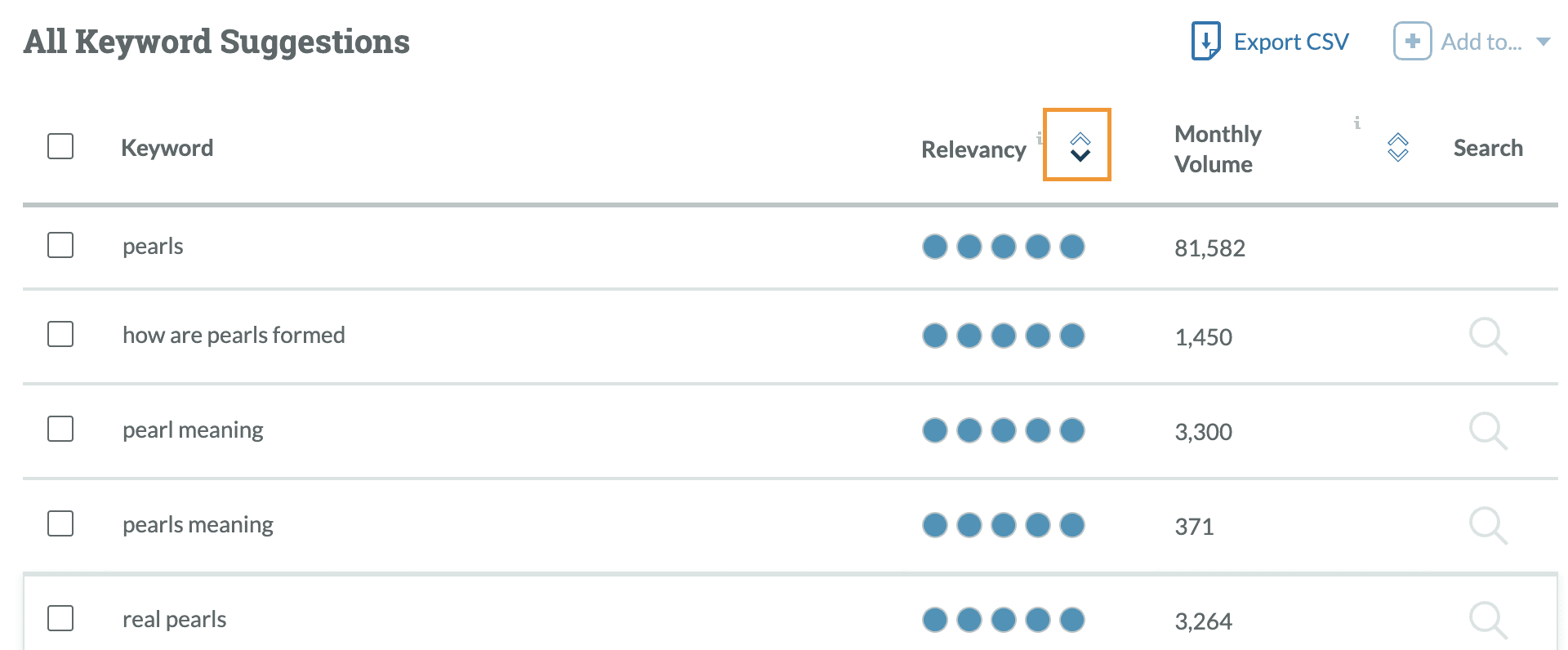
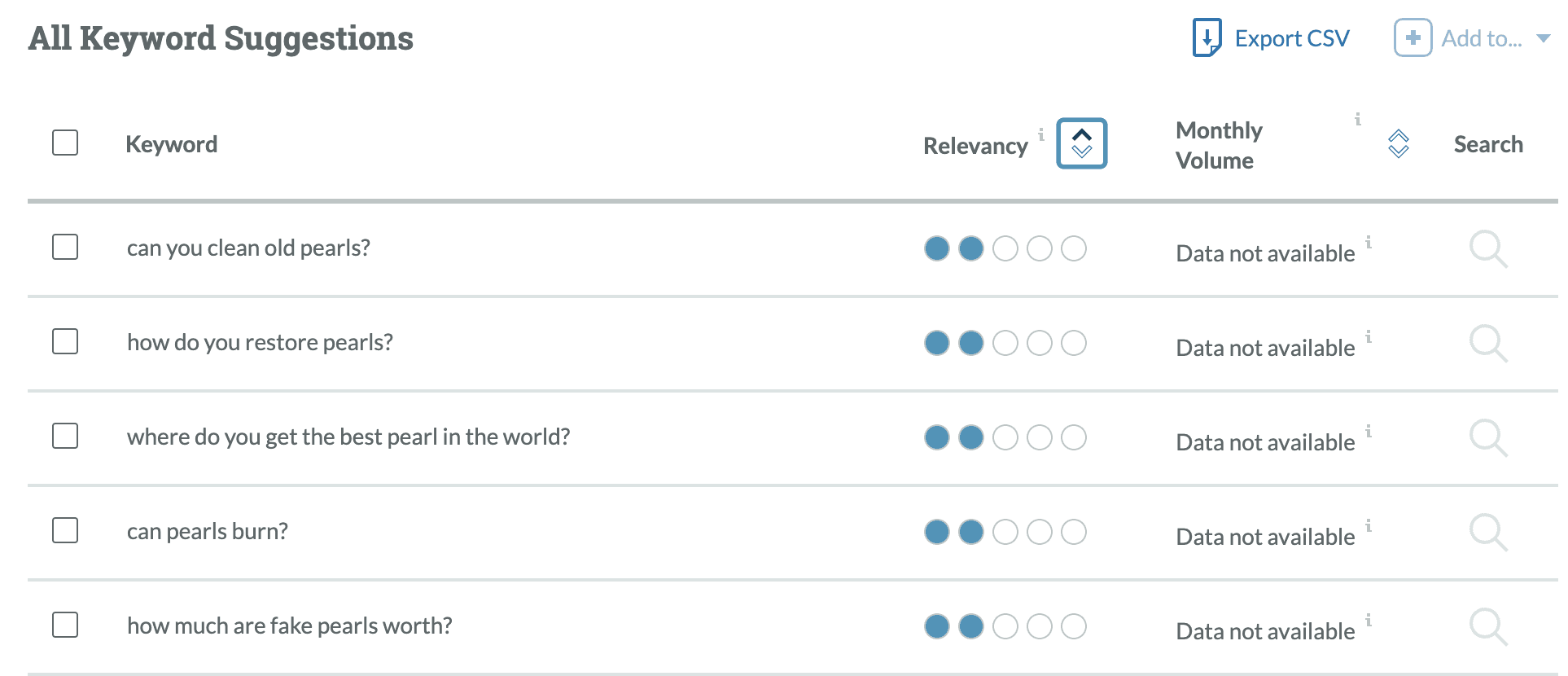
Now reverse the volume filter so that it’s showing lower-volume search terms and scroll down through the end of the tail to explore the lower-volume chatter.
If we don’t have tracked data in our database you can always cross reference with another data set to validate their value.
This is where your industry knowledge comes into play again. Bots, formulas, spreadsheets, and algorithms are all well and good, but don’t discount your own instincts and knowledge.
Use the suggestion filters to your advantage and play around with broader or more specific suggestion types.
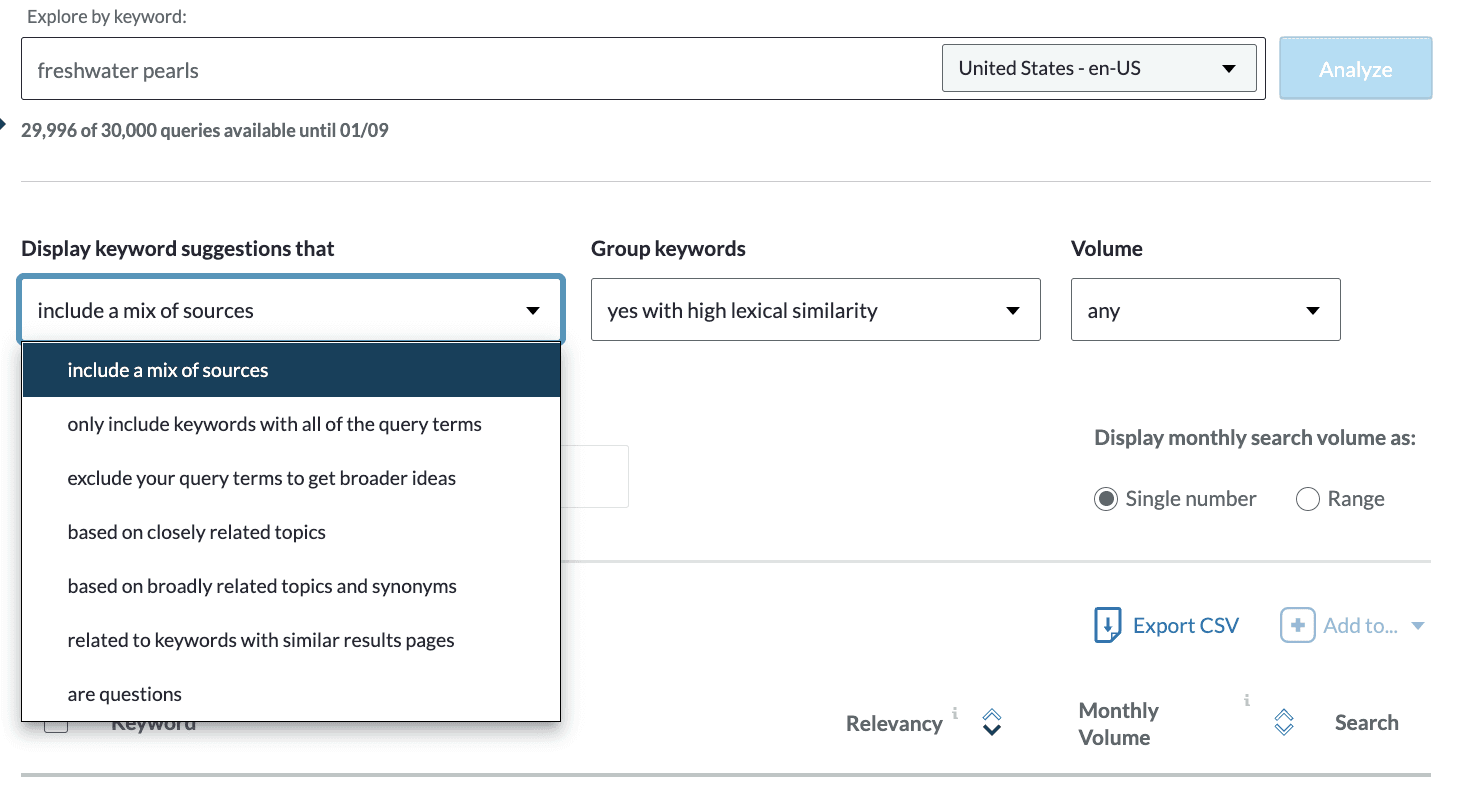
Looking through the suggestions, I’ve noticed that the word “cultured” has popped up a few times.

To see these all bundled together, I want to look at the grouping options in Keyword Explorer. I like the high lexicon groups so I can see how much discussion is going on within my topics.
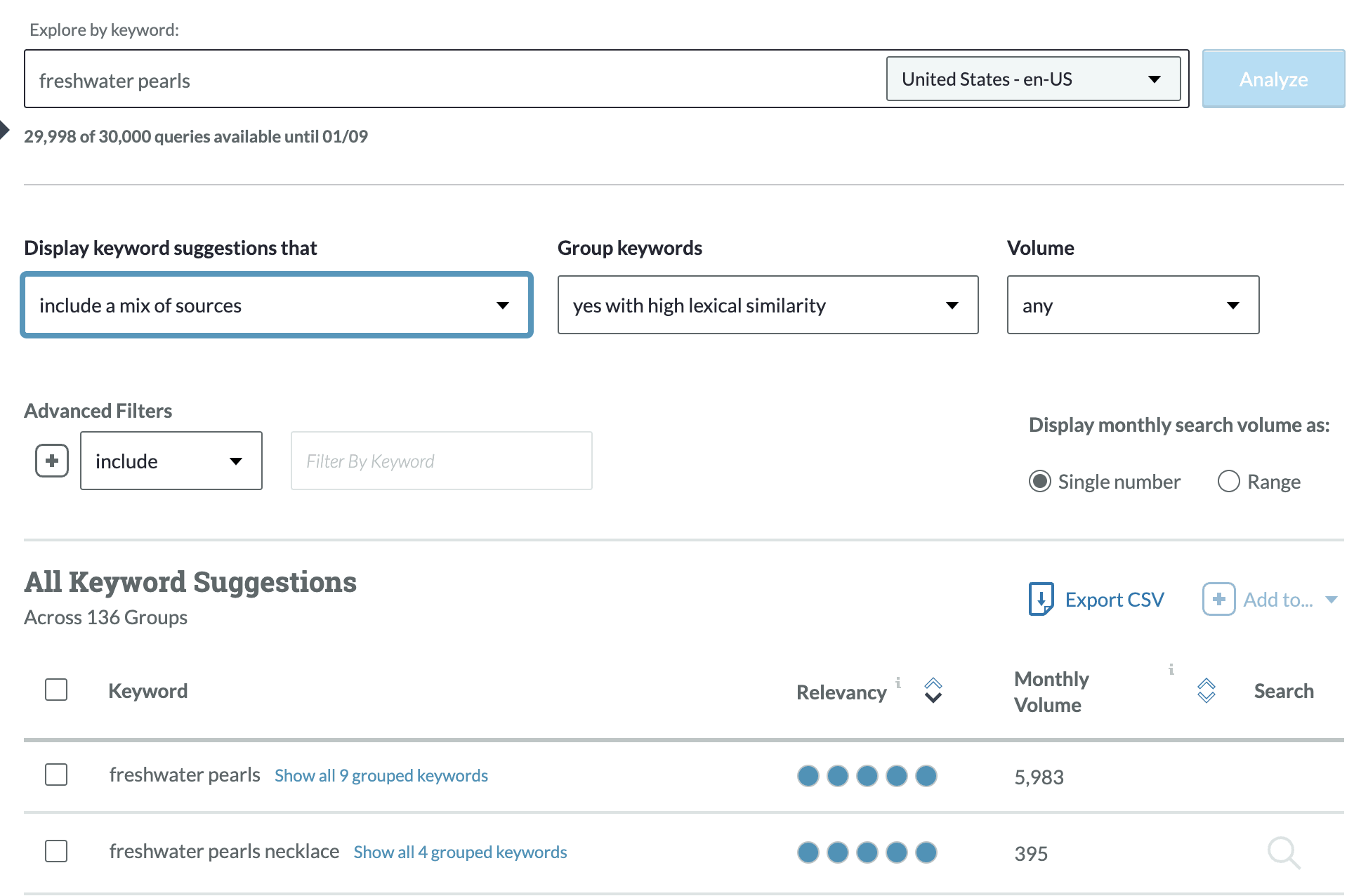
Scroll down and expand that group to get an idea of demand and assess intent.

I’m also interested in the words around “price” and “value,” so I’m doing the same and saving those to my sheet, along with the search volume. A few attempts at researching the “cleaning” of pearls wasn’t very fruitful, so I’ve adjusted my search to “clean freshwater pearls.”
Because I’m a keyword questions fanatic, I’m also going to filter by questions (the bottom option from the drop-down menu):
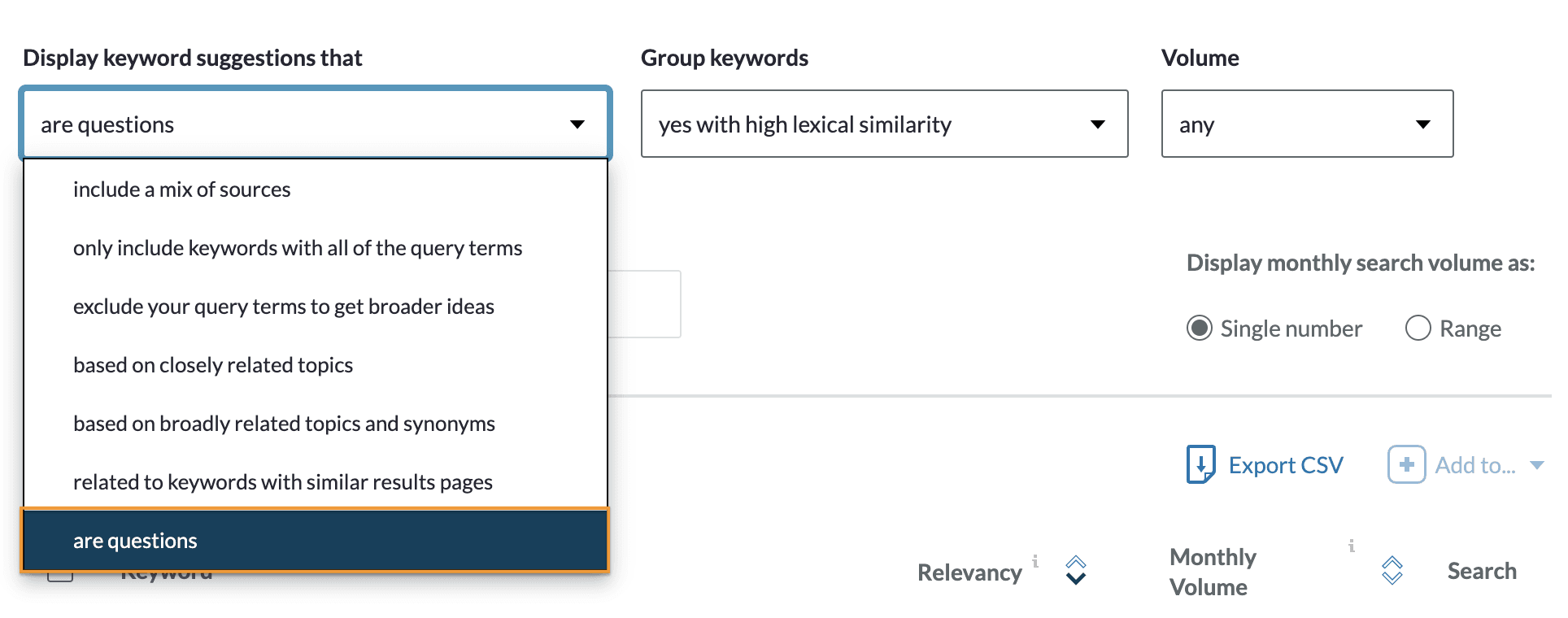
OK! How is our keyword list looking? Pretty darn hot, I reckon! We’ve gathered together a list of keywords and dug into the long tail of these sub-niches, and right alongside we’ve got search volume.

You’ll notice that some of the keywords I discovered in the bronze stage don’t have any data showing up in Keyword Explorer (indicated by the hyphen in the screenshot above). That’s ok — they’re still topics I can research further. This is exactly why we have assessed demand; no wild goose chase for us!
Ok, we’re drawing some conclusions, we’re building our list, and we’re making educated decisions. Congrats on your silver-level keyword wizardry! 😀
Gold medal: Find out who you’re competing with
We’re not operating in a vacuum. There’s always someone out there trying to elbow their way onto the first page. Don’t fall into the trap of thinking that just because it’s a long tail term with a nice chunk of search volume all those clicks will rain down on you. If the terms you’re looking to target already have big names headlining, this could very well alter your roadmap.
To reap the rewards of targeting the long tail, you’ll have to make sure you can outperform your competition.
Manually check the SERPs
Check out who’s showing up in the search engine results page (SERPs) by running a search for your head term. Make sure you’re signed out of Google and in an incognito tab.
We’re focusing on the organic results to find out if there are any weaker URLs you can pick off.
I’ll start with “freshwater pearls” for illustrative purposes.
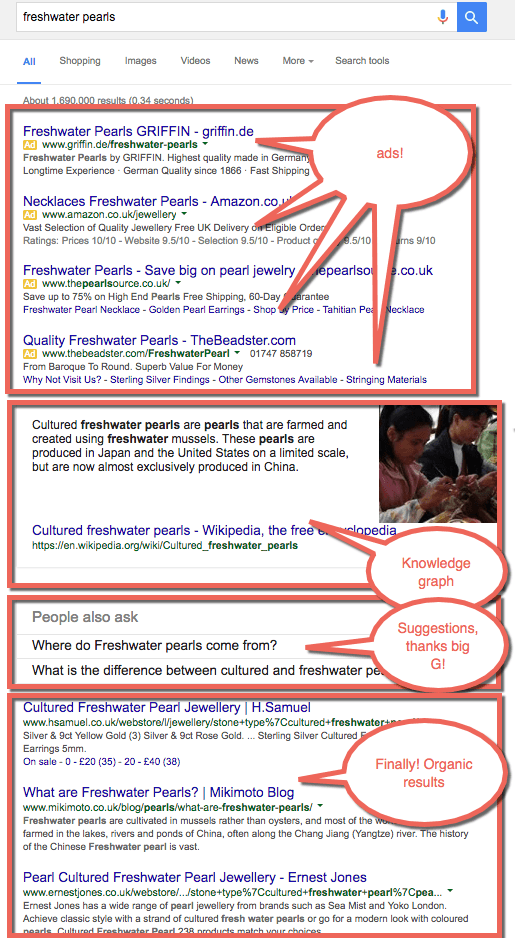
Whoooaaa, this is a noisy page. I’ve had to scroll a whole 2.5cm on my magic mouse (that’s very nearly a whole inch for the imperialists among us) just to see any organic results.
Let’s install the Mozbar to discover some metrics on the fly, like domain authority and back-linking data.
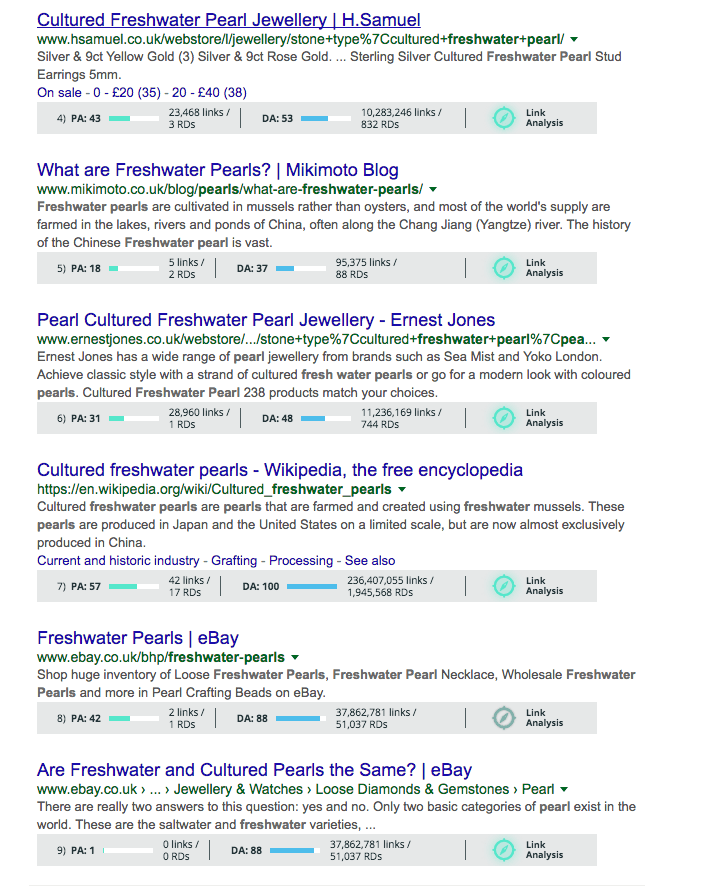
Now, if seeing those big players in the SERPs doesn’t make it clear, looking at the Mozbar metrics certainly does. This is exclusive real estate. It’s dominated by retailers, although Wikipedia gets a place in the middle of the page.
Let’s get into the mind of Google for a second. It — or should I say “they” (I can’t decide if it’s more creepy for Google to be referred to as a singular or plural pronoun. Let’s go with “they”) — anyway, I digress. “They” are guessing that we’re looking to buy pearls, but they’re also offering results on what they are.
This sort of information is offered up by big retailers who have created content that targets the intention of searchers. Mikimoto drives us to their blog post all about where freshwater pearls come from.

As you get deeper into the long tail of your niche, you’ll begin to come across sites you might not be so familiar with. So go and have a peek at their content.
With a little bit of snooping you can easily find out:
-
how relevant the article is
-
if it looks appealing, up to date, and sharable
-
be really judge-y: why not?
Now let’s find some more:
-
when the article was published
-
when their site was created
-
how often their blog is updated
-
how many other sites are linking to the page with Link Explorer
-
how many tweets, likes, etc.
Learn more about how to do a competitor analysis in our free guide, and don’t forget to download the handy worksheet.
Document all of your findings in our spreadsheet from earlier to keep track of the data. This information will now inform you of your chances of ranking for that term.
Manually checking out your competition is something that I would strongly recommend. But we don’t have all the time in the world to check each results page for each keyword we’re interested in.
Keyword Explorer leaps to our rescue again
Run your search and click on “SERP Analysis” to see what the first page looks like, along with authority metrics and social activity.
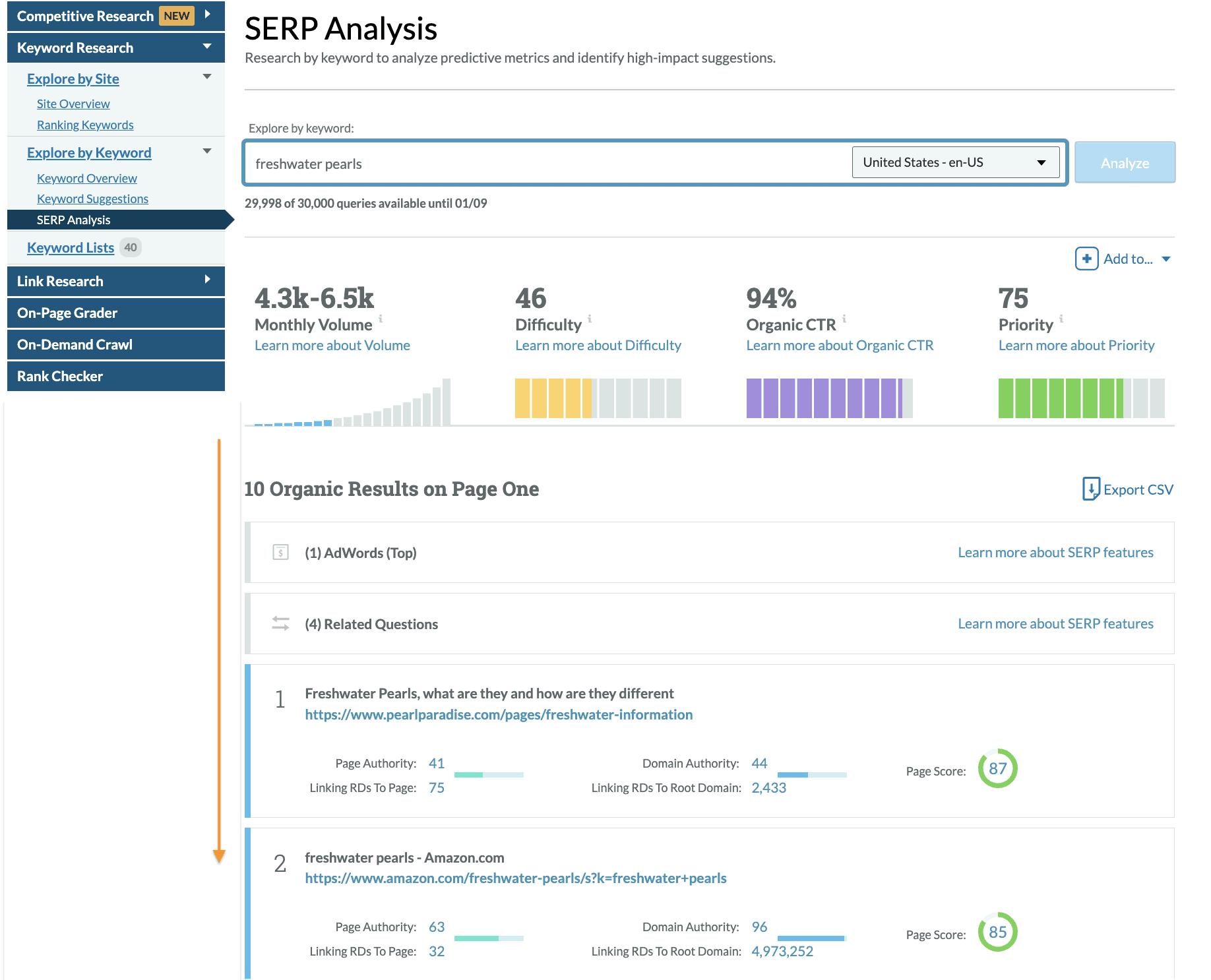
All the metrics for the organic results, like Page Authority, goes into calculating the Difficulty score above (lower is better).
And all those other factors — the ads and suggestions taking up space on the SERPs — that’s what’s used to calculate Organic CTR (higher is better).
Priority is all the other metrics tallied up. You definitely want this to be higher.
So now we have 3 important numerical values we can use to gauge our competition. We can use these values to compare keywords.
After a few searches in Keyword Explorer, you’re going to start hankering for a keyword list or two. For this you’ll need a paid subscription, or a Moz Pro 30-day free trial.
It’s well worth the sign-up; not only do you get 5,000 keyword queries per month and 30 lists (on the Medium plan), but you also get to check out the super-magical-KWE-mega-list-funky-cool metric page. That’s what I call it, just rolls off the tongue, you know?
Okay, fellow list buddies, let’s go and add those terms we’re interested in to our lovely new list.

Then head up to your lists on the top right and open up the one you just created.
Now we can see the spread of demand, competition and SERP features for our whole list.
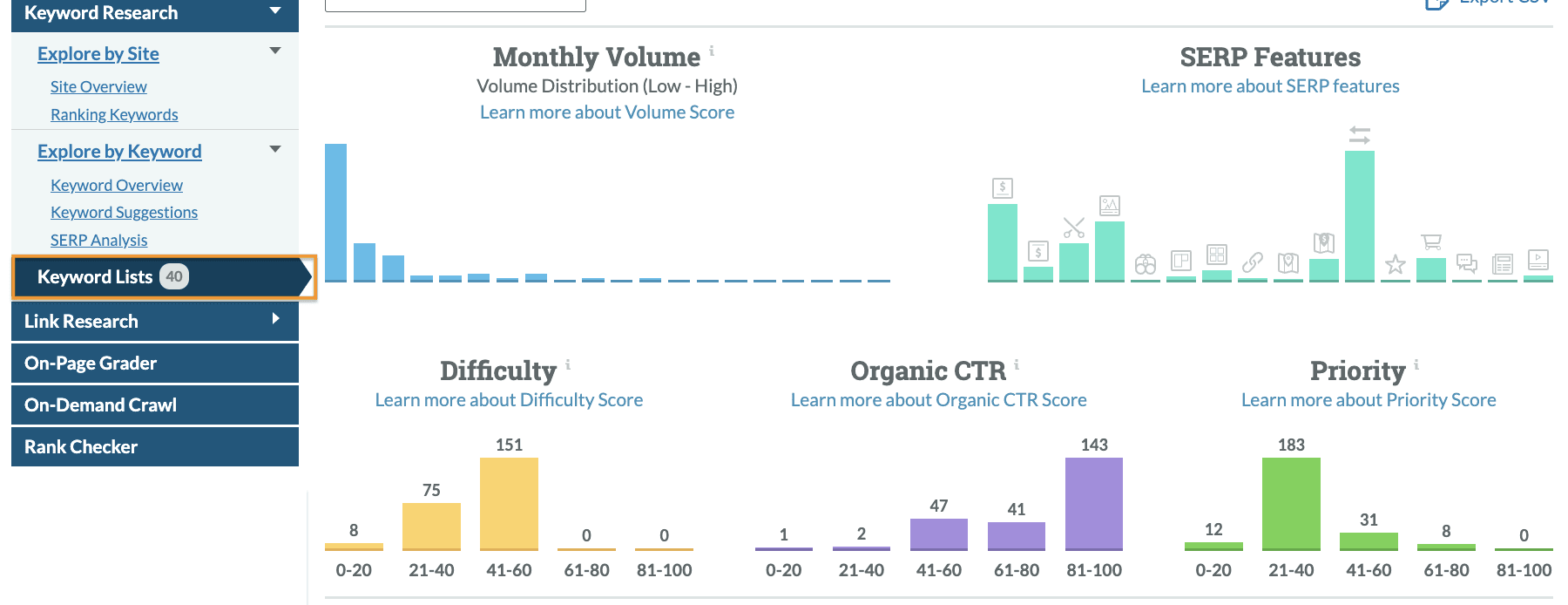
You can compare Volume, SERPS Features, Difficulty, Organic CTR, and Priority across multiple lists, topics, and niches.
How to compare apples with apples
Comparing keywords is something our support team gets questions about all the time.
Should I target this word or that word?
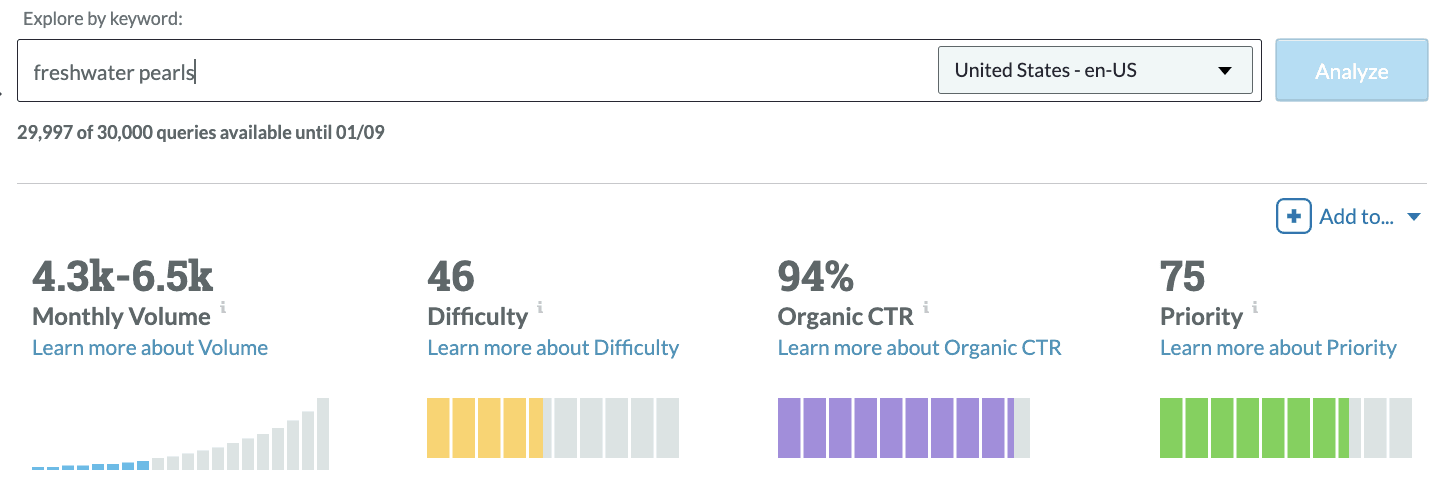
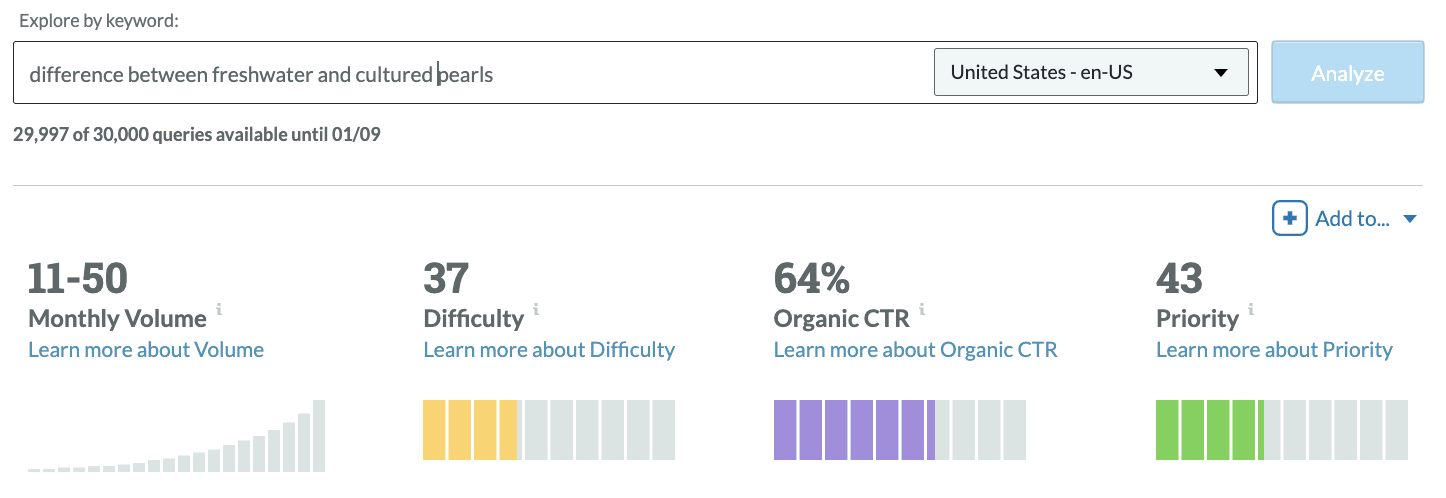
For the long tail keyword, the Volume is a lot lower, Difficulty is also down, the Organic CTR is a bit up, and overall the Priority is down because of the drop in search volume.
But don’t discount it! By targeting these sorts of terms, you’re focusing more on the intent of the searcher. You’re also making your content relevant for all the other neighboring search terms.
Let’s compare the difference between freshwater and cultured pearls with how much are freshwater pearls worth.
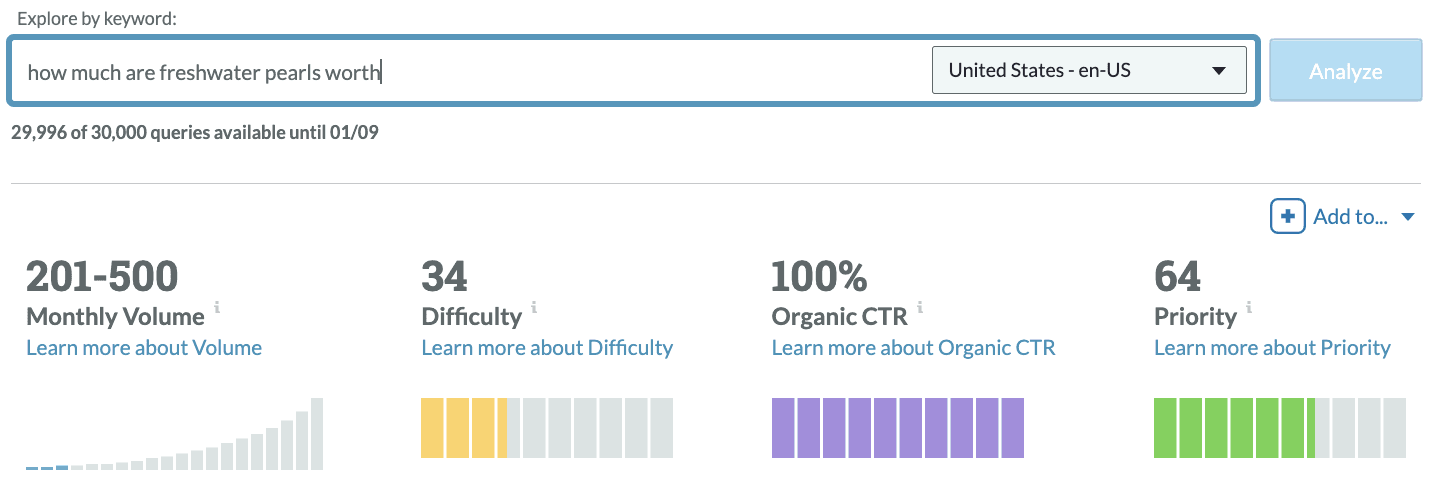
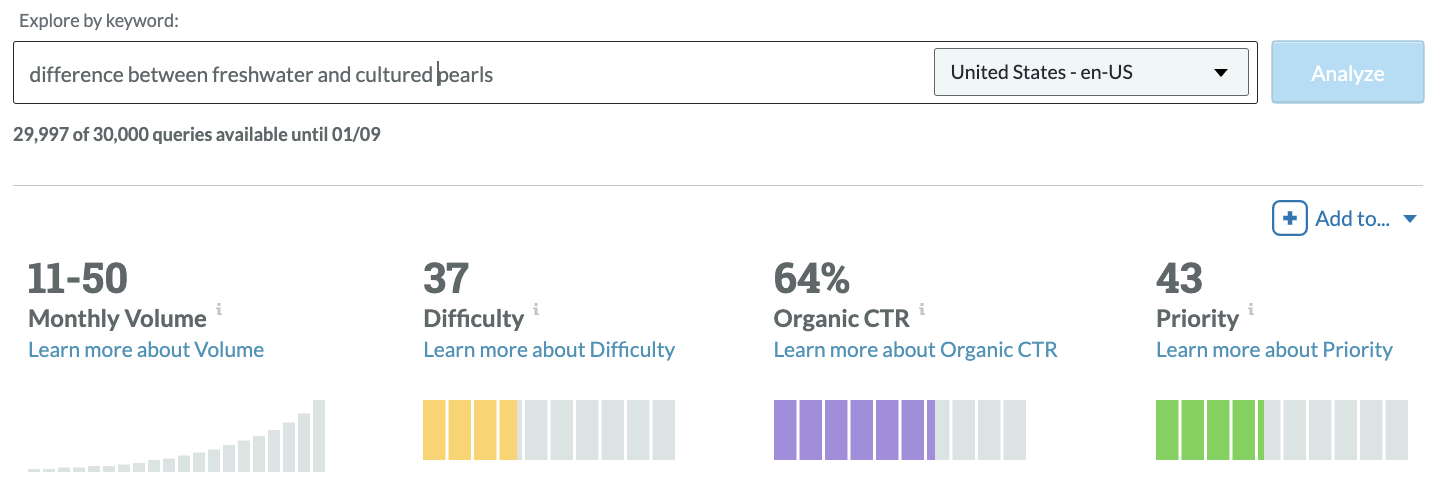
Search volume is the same, but for the keyword how much are freshwater pearls worth Difficulty is up, but so is the overall Priority because the Organic CTR is higher.
But just because you’re picking between two long tail keywords doesn’t mean you’ve fully understood the long tail of search.
You know all those keywords I grabbed for my list earlier in this post? Well, here they are sorted into topics.

Look at all the different ways people search for the same thing. This is what drives the long tail of search — searcher diversity. If you tally all the volume up for the cultured topic, we’ve got a bigger group of keywords and overall more search volume. This is where you can use Keyword Explorer and the long tail to make informed decisions.
You’re laying out your virtual welcome mat for all the potential traffic these terms send.
Platinum level: I lied — there’s one more level!
For all you lovely overachievers out there who have reached the end of this post, I’m going to reward you with one final tip.
You’ve done all the snooping around on your competitors, so you know who you’re up against. You’ve done the research, so you know what keywords to target to begin driving intent-rich traffic.
Now you need to create strong, consistent, and outstanding content.
As Dr Pete confirmed:
We don’t have to work ourselves to death to target the long tail of search. It doesn’t take 10,000 pieces of content to rank for 10,000 variants of a phrase, and Google (and our visitors) would much prefer we not spin out that content. The new, post-NLP (Natural Language Processing) long tail of SEO requires us to understand how our keywords fit into semantic space, mapping their relationships and covering the core concepts. Study your SERPs diligently, and you can find the patterns to turn your own long tail of keywords into a chonky thorax of opportunity.
Here’s where you really have to tip your hat to long tail keywords, because by strategically targeting the long tail you can start to build enough authority in the industry to beat stronger competition and rank higher for more competitive keywords in your niche.
Wrapping up…
The various different keyword phrases that make up the long tail in your industry are vast, often easier to rank for, and indicate stronger intent from the searcher. By targeting them you’ll find you can start to rank for relevant phrases sooner than if you just targeted the head. And over time, if you get the right signals, you’ll be able to rank for keywords with tougher competition. Pretty sweet, huh? Give Moz’s Keyword Explorer tool a whirl and let me know how you get on 🙂
MARKETING
Should Your Brand Shout Its AI and Marketing Plan to the World?

To use AI or not to use AI, that is the question.
Let’s hope things work out better for you than they did for Shakespeare’s mad Danish prince with daddy issues.
But let’s add a twist to that existential question.
CMI’s chief strategy officer, Robert Rose, shares what marketers should really contemplate. Watch the video or read on to discover what he says:
Should you not use AI and be proud of not using it? Dove Beauty did that last week.
Should you use it but keep it a secret? Sports Illustrated did that last year.
Should you use AI and be vocal about using it? Agency giant Brandtech Group picked up the all-in vibe.
Should you not use it but tell everybody you are? The new term “AI washing” is hitting everywhere.
What’s the best option? Let’s explore.
Dove tells all it won’t use AI
Last week, Dove, the beauty brand celebrating 20 years of its Campaign for Real Beauty, pledged it would NEVER use AI in visual communication to portray real people.
In the announcement, they said they will create “Real Beauty Prompt Guidelines” that people can use to create images representing all types of physical beauty through popular generative AI programs. The prompt they picked for the launch video? “The most beautiful woman in the world, according to Dove.”
I applaud them for the powerful ad. But I’m perplexed by Dove issuing a statement saying it won’t use AI for images of real beauty and then sharing a branded prompt for doing exactly that. Isn’t it like me saying, “Don’t think of a parrot eating pizza. Don’t think about a parrot eating pizza,” and you can’t help but think about a parrot eating pizza right now?
Brandtech Group says it’s all in on AI
Now, Brandtech Group, a conglomerate ad agency, is going the other way. It’s going all-in on AI and telling everybody.
This week, Ad Age featured a press release — oops, I mean an article (subscription required) — with the details of how Brandtech is leaning into the takeaway from OpenAI’s Sam Altman, who says 95% of marketing work today can be done by AI.
A Brandtech representative talked about how they pitch big brands with two people instead of 20. They boast about how proud they are that its lean 7,000 staffers compete with 100,000-person teams. (To be clear, showing up to a pitch with 20 people has never been a good thing, but I digress.)
OK, that’s a differentiated approach. They’re all in. Ad Age certainly seemed to like it enough to promote it. Oops, I mean report about it.
False claims of using AI and not using AI
Offshoots of the all-in and never-will approaches also exist.
The term “AI washing” is de rigueur to describe companies claiming to use AI for something that really isn’t AI. The US Securities and Exchange Commission just fined two companies for using misleading statements about their use of AI in their business model. I know one startup technology organization faced so much pressure from their board and investors to “do something with AI” that they put a simple chatbot on their website — a glorified search engine — while they figured out what they wanted to do.
Lastly and perhaps most interestingly, companies have and will use AI for much of what they create but remain quiet about it or desire to keep it a secret. A recent notable example is the deepfake ad of a woman in a car professing the need for people to use a particular body wipe to get rid of body odor. It was purported to be real, but sharp-eyed viewers suspected the fake and called out the company, which then admitted it. Or was that the brand’s intent all along — the AI-use outrage would bring more attention?
This is an AI generated influencer video.
Looks 100% real. Even the interior car detailing.
UGC content for your brand is about to get really cheap. ☠️ pic.twitter.com/2m10RqoOW3
— Jon Elder | Amazon Growth | Private Label (@BlackLabelAdvsr) March 26, 2024
To yell or not to yell about your brand’s AI decision
Should a brand yell from a mountaintop that they use AI to differentiate themselves a la Brandtech? Or should a brand yell they’re never going to use AI to differentiate themselves a la Dove? Or should a brand use it and not yell anything? (I think it’s clear that a brand should not use AI and lie and say it is. That’s the worst of all choices.)
I lean far into not-yelling-from-mountaintop camp.
When I see a CEO proudly exclaim that they laid off 90% of their support workforce because of AI, I’m not surprised a little later when the value of their service is reduced, and the business is failing.
I’m not surprised when I hear “AI made us do it” to rationalize the latest big tech company latest rounds of layoffs. Or when a big consulting firm announces it’s going all-in on using AI to replace its creative and strategic resources.
I see all those things as desperate attempts for short-term attention or a distraction from the real challenge. They may get responses like, “Of course, you had to lay all those people off; AI is so disruptive,” or “Amazing. You’re so out in front of the rest of the pack by leveraging AI to create efficiency, let me cover your story.” Perhaps they get this response, “Your company deserves a bump in stock price because you’re already using this fancy new technology.”
But what happens if the AI doesn’t deliver as promoted? What happens the next time you need to lay off people? What happens the next time you need to prove your technologically forward-leaning?
Yelling out that you’re all in on a disruptive innovation, especially one the public doesn’t yet trust a lot is (at best) a business sugar high. That short-term burst of attention may or may not foul your long-term brand value.
Interestingly, the same scenarios can manifest when your brand proclaims loudly it is all out of AI, as Dove did. The sugar high may not last and now Dove has itself into a messaging box. One slip could cause distrust among its customers. And what if AI gets good at demonstrating diversity in beauty?
I tried Dove’s instructions and prompted ChatGPT for a picture of “the most beautiful woman in the world according to the Dove Real Beauty ad.”
It gave me this. Then this. And this. And finally, this.
She’s absolutely beautiful, but she doesn’t capture the many facets of diversity Dove has demonstrated in its Real Beauty campaigns. To be clear, Dove doesn’t have any control over generating the image. Maybe the prompt worked well for Dove, but it didn’t for me. Neither Dove nor you can know how the AI tool will behave.
To use AI or not to use AI?
When brands grab a microphone to answer that question, they work from an existential fear about the disruption’s meaning. They do not exhibit the confidence in their actions to deal with it.
Let’s return to Hamlet’s soliloquy:
Thus conscience doth make cowards of us all;
And thus the native hue of resolution
Is sicklied o’er with the pale cast of thought,
And enterprises of great pith and moment
With this regard their currents turn awry
And lose the name of action.
In other words, Hamlet says everybody is afraid to take real action because they fear the unknown outcome. You could act to mitigate or solve some challenges, but you don’t because you don’t trust yourself.
If I’m a brand marketer for any business (and I am), I’m going to take action on AI for my business. But until I see how I’m going to generate value with AI, I’m going to be circumspect about yelling or proselytizing how my business’ future is better.
HANDPICKED RELATED CONTENT:
Cover image by Joseph Kalinowski/Content Marketing Institute
MARKETING
How to Use AI For a More Effective Social Media Strategy, According to Ross Simmonds

Welcome to Creator Columns, where we bring expert HubSpot Creator voices to the Blogs that inspire and help you grow better.
It’s the age of AI, and our job as marketers is to keep up.
My team at Foundation Marketing recently conducted an AI Marketing study surveying hundreds of marketers, and more than 84% of all leaders, managers, SEO experts, and specialists confirmed that they used AI in the workplace.

If you can overlook the fear-inducing headlines, this technology is making social media marketers more efficient and effective than ever. Translation: AI is good news for social media marketers.
In fact, I predict that the marketers not using AI in their workplace will be using it before the end of this year, and that number will move closer and closer to 100%.
Social media and AI are two of the most revolutionizing technologies of the last few decades. Social media has changed the way we live, and AI is changing the way we work.
So, I’m going to condense and share the data, research, tools, and strategies that the Foundation Marketing Team and I have been working on over the last year to help you better wield the collective power of AI and social media.
Let’s jump into it.
What’s the role of AI in social marketing strategy?
In a recent episode of my podcast, Create Like The Greats, we dove into some fascinating findings about the impact of AI on marketers and social media professionals. Take a listen here:
Let’s dive a bit deeper into the benefits of this technology:
Benefits of AI in Social Media Strategy
AI is to social media what a conductor is to an orchestra — it brings everything together with precision and purpose. The applications of AI in a social media strategy are vast, but the virtuosos are few who can wield its potential to its fullest.
AI to Conduct Customer Research
Imagine you’re a modern-day Indiana Jones, not dodging boulders or battling snakes, but rather navigating the vast, wild terrain of consumer preferences, trends, and feedback.
This is where AI thrives.
Using social media data, from posts on X to comments and shares, AI can take this information and turn it into insights surrounding your business and industry. Let’s say for example you’re a business that has 2,000 customer reviews on Google, Yelp, or a software review site like Capterra.
Leveraging AI you can now have all 2,000 of these customer reviews analyzed and summarized into an insightful report in a matter of minutes. You simply need to download all of them into a doc and then upload them to your favorite Generative Pre-trained Transformer (GPT) to get the insights and data you need.
But that’s not all.
You can become a Prompt Engineer and write ChatGPT asking it to help you better understand your audience. For example, if you’re trying to come up with a persona for people who enjoy marathons but also love kombucha you could write a prompt like this to ChatGPT:

The response that ChatGPT provided back is quite good:

Below this it went even deeper by including a lot of valuable customer research data:
- Demographics
- Psychographics
- Consumer behaviors
- Needs and preferences
And best of all…
It also included marketing recommendations.
The power of AI is unbelievable.
Social Media Content Using AI
AI’s helping hand can be unburdening for the creative spirit.
Instead of marketers having to come up with new copy every single month for posts, AI Social Caption generators are making it easier than ever to craft catchy status updates in the matter of seconds.
Tools like HubSpot make it as easy as clicking a button and telling the AI tool what you’re looking to create a post about:

The best part of these AI tools is that they’re not limited to one channel.
Your AI social media content assistant can help you with LinkedIn content, X content, Facebook content, and even the captions that support your post on Instagram.
It can also help you navigate hashtags:

With AI social media tools that generate content ideas or even write posts, it’s not about robots replacing humans. It’s about making sure that the human creators on your team are focused on what really matters — adding that irreplaceable human touch.
Enhanced Personalization
You know that feeling when a brand gets you, like, really gets you?
AI makes that possible through targeted content that’s tailored with a level of personalization you’d think was fortune-telling if the data didn’t paint a starker, more rational picture.
What do I mean?
Brands can engage more quickly with AI than ever before. In the early 2000s, a lot of brands spent millions of dollars to create social media listening rooms where they would hire social media managers to find and engage with any conversation happening online.
Thanks to AI, brands now have the ability to do this at scale with much fewer people all while still delivering quality engagement with the recipient.
Analytics and Insights
Tapping into AI to dissect the data gives you a CSI-like precision to figure out what works, what doesn’t, and what makes your audience tick. It’s the difference between guessing and knowing.
The best part about AI is that it can give you almost any expert at your fingertips.
If you run a report surrounding the results of your social media content strategy directly from a site like LinkedIn, AI can review the top posts you’ve shared and give you clear feedback on what type of content is performing, why you should create more of it, and what days of the week your content is performing best.
This type of insight that would typically take hours to understand.
Now …
Thanks to the power of AI you can upload a spreadsheet filled with rows and columns of data just to be met with a handful of valuable insights a few minutes later.
Improved Customer Service
Want 24/7 support for your customers?
It’s now possible without human touch.
Chatbots powered by AI are taking the lead on direct messaging experiences for brands on Facebook and other Meta properties to offer round-the-clock assistance.
The fact that AI can be trained on past customer queries and data to inform future queries and problems is a powerful development for social media managers.
Advertising on Social Media with AI
The majority of ad networks have used some variation of AI to manage their bidding system for years. Now, thanks to AI and its ability to be incorporated in more tools, brands are now able to use AI to create better and more interesting ad campaigns than ever before.
Brands can use AI to create images using tools like Midjourney and DALL-E in seconds.
Brands can use AI to create better copy for their social media ads.
Brands can use AI tools to support their bidding strategies.
The power of AI and social media is continuing to evolve daily and it’s not exclusively found in the organic side of the coin. Paid media on social media is being shaken up due to AI just the same.
How to Implement AI into Your Social Media Strategy
Ready to hit “Go” on your AI-powered social media revolution?
Don’t just start the engine and hope for the best. Remember the importance of building a strategy first. In this video, you can learn some of the most important factors ranging from (but not limited to) SMART goals and leveraging influencers in your day-to-day work:
The following seven steps are crucial to building a social media strategy:
- Identify Your AI and Social Media Goals
- Validate Your AI-Related Assumptions
- Conduct Persona and Audience Research
- Select the Right Social Channels
- Identify Key Metrics and KPIs
- Choose the Right AI Tools
- Evaluate and Refine Your Social Media and AI Strategy
Keep reading, roll up your sleeves, and follow this roadmap:
1. Identify Your AI and Social Media Goals
If you’re just dipping your toes into the AI sea, start by defining clear objectives.
Is it to boost engagement? Streamline your content creation? Or simply understand your audience better? It’s important that you spend time understanding what you want to achieve.
For example, say you’re a content marketing agency like Foundation and you’re trying to increase your presence on LinkedIn. The specificity of this goal will help you understand the initiatives you want to achieve and determine which AI tools could help you make that happen.
Are there AI tools that will help you create content more efficiently? Are there AI tools that will help you optimize LinkedIn Ads? Are there AI tools that can help with content repurposing? All of these things are possible and having a goal clearly identified will help maximize the impact. Learn more in this Foundation Marketing piece on incorporating AI into your content workflow.
Once you have identified your goals, it’s time to get your team on board and assess what tools are available in the market.
Recommended Resources:
2. Validate Your AI-Related Assumptions
Assumptions are dangerous — especially when it comes to implementing new tech.
Don’t assume AI is going to fix all your problems.
Instead, start with small experiments and track their progress carefully.
3. Conduct Persona and Audience Research
Social media isn’t something that you can just jump into.
You need to understand your audience and ideal customers. AI can help with this, but you’ll need to be familiar with best practices. If you need a primer, this will help:
Once you understand the basics, consider ways in which AI can augment your approach.
4. Select the Right Social Channels
Not every social media channel is the same.
It’s important that you understand what channel is right for you and embrace it.
The way you use AI for X is going to be different from the way you use AI for LinkedIn. On X, you might use AI to help you develop a long-form thread that is filled with facts and figures. On LinkedIn however, you might use AI to repurpose a blog post and turn it into a carousel PDF. The content that works on X and that AI can facilitate creating is different from the content that you can create and use on LinkedIn.
The audiences are different.
The content formats are different.
So operate and create a plan accordingly.
Recommended Tools and Resources:
5. Identify Key Metrics and KPIs
What metrics are you trying to influence the most?
Spend time understanding the social media metrics that matter to your business and make sure that they’re prioritized as you think about the ways in which you use AI.
These are a few that matter most:
- Reach: Post reach signifies the count of unique users who viewed your post. How much of your content truly makes its way to users’ feeds?
- Clicks: This refers to the number of clicks on your content or account. Monitoring clicks per campaign is crucial for grasping what sparks curiosity or motivates people to make a purchase.
- Engagement: The total social interactions divided by the number of impressions. This metric reveals how effectively your audience perceives you and their readiness to engage.
Of course, it’s going to depend greatly on your business.
But with this information, you can ensure that your AI social media strategy is rooted in goals.
6. Choose the Right AI Tools
The AI landscape is filled with trash and treasure.
Pick AI tools that are most likely to align with your needs and your level of tech-savviness.
For example, if you’re a blogger creating content about pizza recipes, you can use HubSpot’s AI social caption generator to write the message on your behalf:

The benefit of an AI tool like HubSpot and the caption generator is that what at one point took 30-40 minutes to come up with — you can now have it at your fingertips in seconds. The HubSpot AI caption generator is trained on tons of data around social media content and makes it easy for you to get inspiration or final drafts on what can be used to create great content.
Consider your budget, the learning curve, and what kind of support the tool offers.
7. Evaluate and Refine Your Social Media and AI Strategy
AI isn’t a magic wand; it’s a set of complex tools and technology.
You need to be willing to pivot as things come to fruition.
If you notice that a certain activity is falling flat, consider how AI can support that process.
Did you notice that your engagement isn’t where you want it to be? Consider using an AI tool to assist with crafting more engaging social media posts.
Make AI Work for You — Now and in the Future
AI has the power to revolutionize your social media strategy in ways you may have never thought possible. With its ability to conduct customer research, create personalized content, and so much more, thinking about the future of social media is fascinating.
We’re going through one of the most interesting times in history.
Stay equipped to ride the way of AI and ensure that you’re embracing the best practices outlined in this piece to get the most out of the technology.
MARKETING
Advertising in local markets: A playbook for success

Many brands, such as those in the home services industry or a local grocery chain, market to specific locations, cities or regions. There are also national brands that want to expand in specific local markets.
Regardless of the company or purpose, advertising on a local scale has different tactics than on a national scale. Brands need to connect their messaging directly with the specific communities they serve and media to their target demo. Here’s a playbook to help your company succeed when marketing on a local scale.
1. Understand local vs. national campaigns
Local advertising differs from national campaigns in several ways:
- Audience specificity: By zooming in on precise geographic areas, brands can tailor messaging to align with local communities’ customs, preferences and nuances. This precision targeting ensures that your message resonates with the right target audience.
- Budget friendliness: Local advertising is often more accessible for small businesses. Local campaign costs are lower, enabling brands to invest strategically within targeted locales. This budget-friendly nature does not diminish the need for strategic planning; instead, it emphasizes allocating resources wisely to maximize returns. As a result, testing budgets can be allocated across multiple markets to maximize learnings for further market expansion.
- Channel selection: Selecting the correct channels is vital for effective local advertising. Local newspapers, radio stations, digital platforms and community events each offer advantages. The key lies in understanding where your target audience spends time and focusing efforts to ensure optimal engagement.
- Flexibility and agility: Local campaigns can be adjusted more swiftly in response to market feedback or changes, allowing brands to stay relevant and responsive.
Maintaining brand consistency across local touchpoints reinforces brand identity and builds a strong, recognizable brand across markets.
2. Leverage customized audience segmentation
Customized audience segmentation is the process of dividing a market into distinct groups based on specific demographic criteria. This marketing segmentation supports the development of targeted messaging and media plans for local markets.
For example, a coffee chain might cater to two distinct segments: young professionals and retirees. After identifying these segments, the chain can craft messages, offers and media strategies relating to each group’s preferences and lifestyle.
To reach young professionals in downtown areas, the chain might focus on convenience, quality coffee and a vibrant atmosphere that is conducive to work and socializing. Targeted advertising on Facebook, Instagram or Connected TV, along with digital signage near office complexes, could capture the attention of this demographic, emphasizing quick service and premium blends.
Conversely, for retirees in residential areas, the chain could highlight a cozy ambiance, friendly service and promotions such as senior discounts. Advertisements in local print publications, community newsletters, radio stations and events like senior coffee mornings would foster a sense of community and belonging.
Dig deeper: Niche advertising: 7 actionable tactics for targeted marketing
3. Adapt to local market dynamics
Various factors influence local market dynamics. Brands that navigate changes effectively maintain a strong audience connection and stay ahead in the market. Here’s how consumer sentiment and behavior may evolve within a local market and the corresponding adjustments brands can make.
- Cultural shifts, such as changes in demographics or societal norms, can alter consumer preferences within a local community. For example, a neighborhood experiencing gentrification may see demand rise for specific products or services.
- Respond by updating your messaging to reflect the evolving cultural landscape, ensuring it resonates with the new demographic profile.
- Economic conditions are crucial. For example, during downturns, consumers often prioritize value and practicality.
- Highlight affordable options or emphasize the practical benefits of your offerings to ensure messaging aligns with consumers’ financial priorities. The impact is unique to each market and the marketing message must also be dynamic.
- Seasonal trends impact consumer behavior.
- Align your promotions and creative content with changing seasons or local events to make your offerings timely and relevant.
- New competitors. The competitive landscape demands vigilance because new entrants or innovative competitor campaigns can shift consumer preferences.
- Differentiate by focusing on your unique selling propositions, such as quality, customer service or community involvement, to retain consumer interest and loyalty.
4. Apply data and predictive analytics
Data and predictive analytics are indispensable tools for successfully reaching local target markets. These technologies provide consumer behavior insights, enabling you to anticipate market trends and adjust strategies proactively.
- Price optimization: By analyzing consumer demand, competitor pricing and market conditions, data analytics enables you to set prices that attract customers while ensuring profitability.
- Competitor analysis: Through analysis, brands can understand their positioning within the local market landscape and identify opportunities and threats. Predictive analytics offer foresight into competitors’ potential moves, allowing you to strategize effectively to maintain a competitive edge.
- Consumer behavior: Forecasting consumer behavior allows your brand to tailor offerings and marketing messages to meet evolving consumer needs and enhance engagement.
- Marketing effectiveness: Analytics track the success of advertising campaigns, providing insights into which strategies drive conversions and sales. This feedback loop enables continuous optimization of marketing efforts for maximum impact.
- Inventory management: In supply chain management, data analytics predict demand fluctuations, ensuring inventory levels align with market needs. This efficiency prevents stockouts or excess inventory, optimizing operational costs and meeting consumer expectations.
Dig deeper: Why you should add predictive modeling to your marketing mix
5. Counter external market influences
Consider a clothing retailer preparing for a spring collection launch. By analyzing historical weather data and using predictive analytics, the brand forecasts an unseasonably cool start to spring. Anticipating this, the retailer adjusts its campaign to highlight transitional pieces suitable for cooler weather, ensuring relevance despite an unexpected chill.
Simultaneously, predictive models signal an upcoming spike in local media advertising rates due to increased market demand. Retailers respond by reallocating a portion of advertising budgets to digital channels, which offer more flexibility and lower costs than traditional media. This shift enables brands to maintain visibility and engagement without exceeding budget, mitigating the impact of external forces on advertising.
6. Build consumer confidence with messaging
Localized messaging and tailored customer service enhance consumer confidence by demonstrating your brand’s understanding of the community. For instance, a grocery store that curates cooking classes featuring local cuisine or sponsors community events shows commitment to local culture and consumer interests.
Similarly, a bookstore highlighting local authors or topics relevant to the community resonates with local customers. Additionally, providing service that addresses local needs — such as bilingual service and local event support — reinforces the brand’s values and response to the community.
Through these localized approaches, brands can build trust and loyalty, bridging the gap between corporate presence and local relevance.
7. Dominate with local advertising
To dominate local markets, brands must:
- Harness hyper-targeted segmentation and geo-targeted advertising to reach and engage precise audiences.
- Create localized content that reflects community values, engage in community events, optimize campaigns for mobile and track results.
- Fine-tune strategies, outperform competitors and foster lasting relationships with customers.
These strategies will enable your message to resonate with local consumers, differentiate you in competitive markets and ensure you become a major player in your specific area.
Dig deeper: The 5 critical elements for local marketing success
Opinions expressed in this article are those of the guest author and not necessarily MarTech. Staff authors are listed here.
-

 PPC5 days ago
PPC5 days ago19 Best SEO Tools in 2024 (For Every Use Case)
-
SEARCHENGINES7 days ago
Daily Search Forum Recap: April 17, 2024
-

 SEO7 days ago
SEO7 days agoAn In-Depth Guide And Best Practices For Mobile SEO
-
SEARCHENGINES6 days ago
Daily Search Forum Recap: April 18, 2024
-

 MARKETING6 days ago
MARKETING6 days agoEcommerce evolution: Blurring the lines between B2B and B2C
-
SEARCHENGINES5 days ago
Daily Search Forum Recap: April 19, 2024
-

 SEO6 days ago
SEO6 days ago2024 WordPress Vulnerability Report Shows Errors Sites Keep Making
-

 WORDPRESS5 days ago
WORDPRESS5 days agoHow to Make $5000 of Passive Income Every Month in WordPress














![How to Use AI For a More Effective Social Media Strategy, According to Ross Simmonds Download Now: The 2024 State of Social Media Trends [Free Report]](https://articles.entireweb.com/wp-content/uploads/2024/04/How-to-Use-AI-For-a-More-Effective-Social-Media.png)

